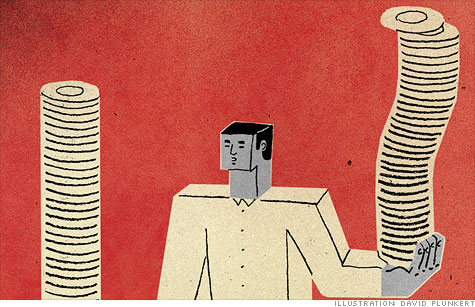Search News

(MONEY Magazine) -- The ability of bonds to live up to their safe-haven, risk-dampening rep is looking shaky lately. Yields are abysmally low, the prospect of a price drop is high if interest rates rise, and all that wrangling over the debt ceiling didn't exactly inspire confidence.
That's why a lot of income investors are thinking about ditching bonds in favor of dividend stocks; plenty are paying double what you can currently earn on a five-year Treasury note. So is it time to abandon your bonds and pile up on high-quality dividend payers? Not so fast.
Bond bears don't maul
Bond bubblistas are right in warning that the inevitable, eventual rise in interest rates from today's near-record lows will trigger declines in bond prices. But the potential losses are not likely to ever approach the magnitude of the damage we've seen with bursting bubbles in stocks or real estate.
The last time bonds smacked into a strong headwind was in 1993 - 94, when the yield of 10-year Treasuries spiked from 5.3% to 8% over a 13-month stretch. Yet the Barclays Aggregate Bond index lost only 3.5%, as interest payouts cushioned the blow of falling prices.
"There's no guarantee that in some years losses won't be bigger," says Charles Schwab fixed-income strategist Kathy Jones. "But that's not a record that suggests massive losses."
Dividend payers falter, too
It's not as if dividend stocks are draped in a protective invisa-shield that makes them impervious to stock bear markets.
From late 2007 through the bear market low in March 2009, an index of the most reliable dividend-paying companies, those that have boosted payouts for at least 25 consecutive years, lost 45%.
"The worst for dividend stocks can be decidedly worse than the worst for bonds," notes Ned Notzon, the head of T. Rowe Price's asset-allocation committee.
Moreover, companies can and do cut dividends when earnings take a dive. In 2009 more than 800 companies slashed a record $58 billion in payouts. By contrast, bond issuers must keep making interest payments or risk default, an uncommon event.
Small shifts boost safety
For extra protection, pay attention to duration - a measure of a bond fund's sensitivity to interest rates.
Send your fixed income investing questions to The Help Desk.
Here's how it works: For every percentage point change in rates, a fund will gain or lose value in proportion to its duration. So a fund with a duration of, say, five years will fall 5% for every one point jump in rates.
Jones suggests a combined duration of about four years for your bond portfolio as a comfortable sweet spot. These days you'd earn a yield of 2.5% to 3% or so, and your losses would probably be small if rates rise.
Then, if you want to capture more yield by investing in dividend stocks, do so by reorienting your stock portfolio to focus on income payers, rather than make a big move out of bonds, Notzon advises.
"Bonds generally won't do as well as stocks in a slow- to moderate-growth economy," he says, "but you need them as a stabilizing force for your portfolio." ![]()

Carlos Rodriguez is trying to rid himself of $15,000 in credit card debt, while paying his mortgage and saving for his son's college education.
| Overnight Avg Rate | Latest | Change | Last Week |
|---|---|---|---|
| 30 yr fixed | 3.80% | 3.88% | |
| 15 yr fixed | 3.20% | 3.23% | |
| 5/1 ARM | 3.84% | 3.88% | |
| 30 yr refi | 3.82% | 3.93% | |
| 15 yr refi | 3.20% | 3.23% |
Today's featured rates: